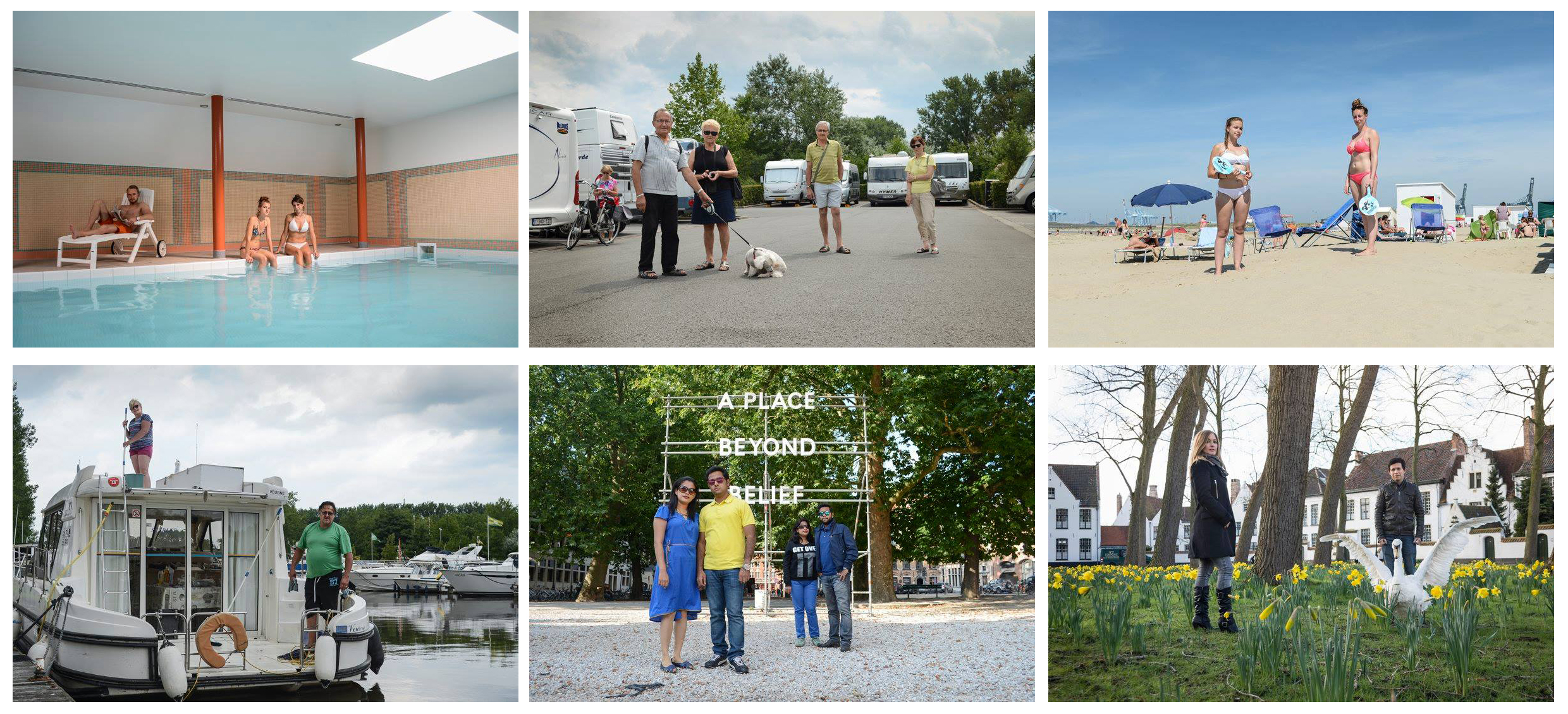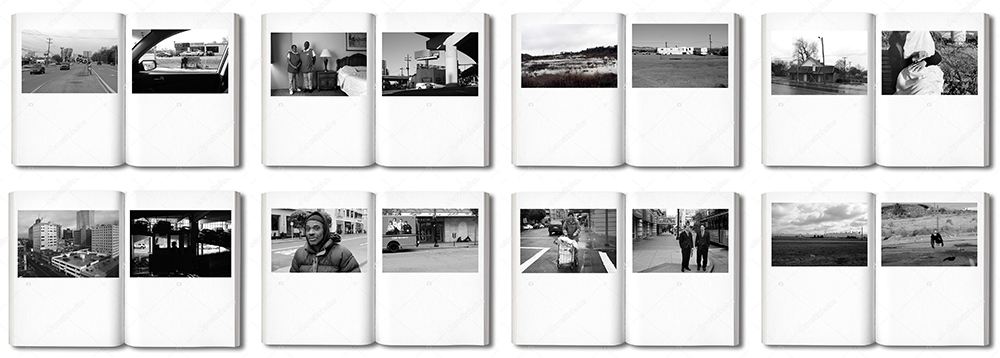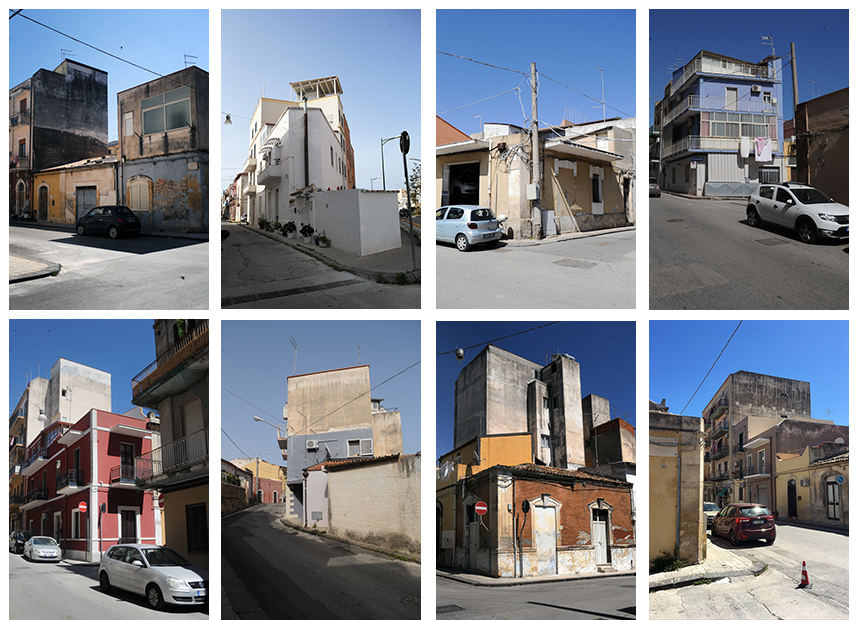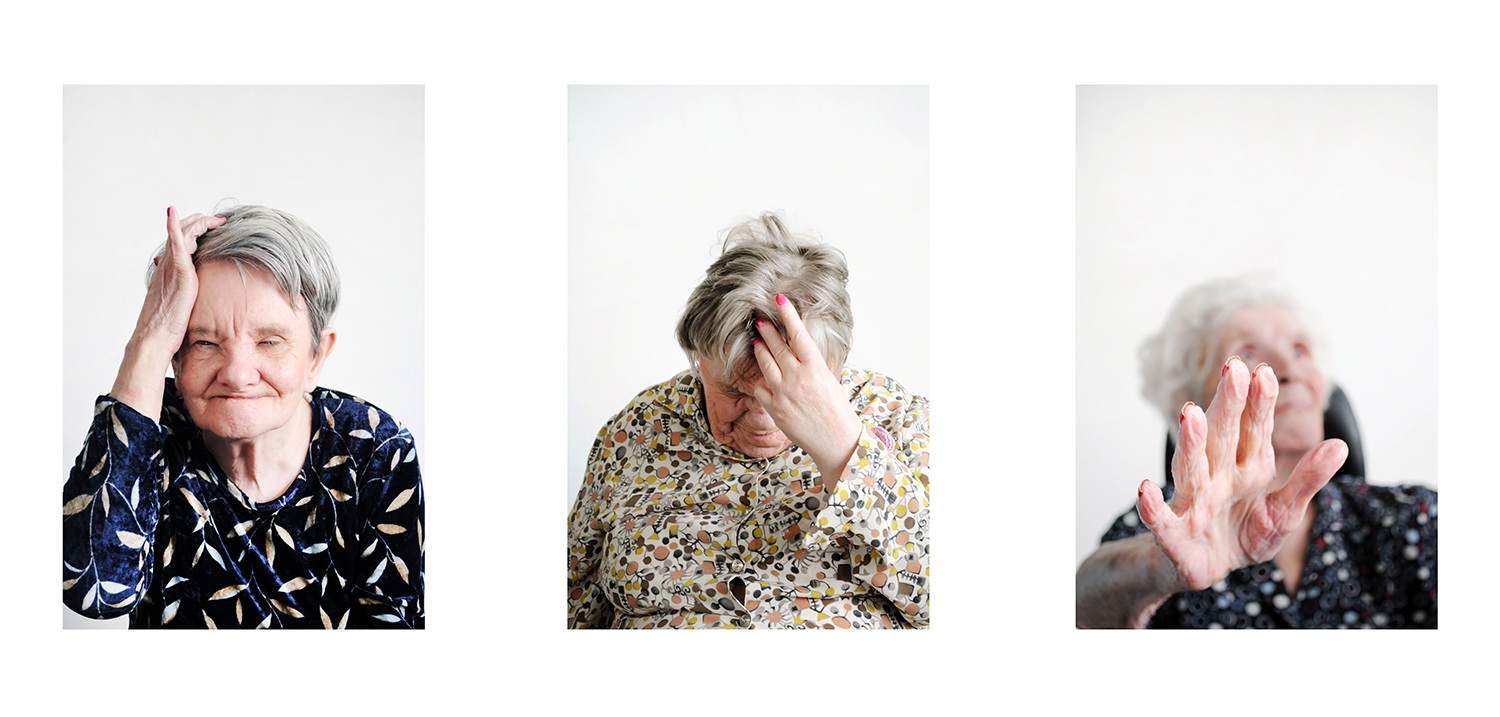|
|
||||||||||||||
|
|
UNPREDICTABLE MEANINGS - Conceptual Photographs are not determined. And only partially identified. Images get other meanings depending on the context in which they are placed. Photography describes not reality only. When organizing images create a new magic visual language. Unexpectedly connections between images are created, regardless the scale of the objects. The original content of the images is out of sight. They manifest themselves in a formal way in the first place. They exhibit themselves as structures and patterns.
From the chaos of every day, Rabaey produces images that are associated with each other long after shooting. His modus operandi changes here; sometimes the connection is based on formal aspects, sometimes on content. Although they have arisen independently of each other in time and space; the author forces them to compose a mutual relationship. Even more; this link makes their meaning unpredictable. This shift throws the viewer back on himself. Is this about what the photographer wants to show us or about what the attentive viewer can notice?
WHY SHOULD I LEAVE YOU, TO WOUND MYSELF UPON THE SHARP EDGES OF THE NIGHT? - Photo Essay
The title and inspiration for the series is the final chord of the poem Taxi by the American poet Amy Lowell (1874 - 1927). There is a paradox in the night. There is a certain threat, but at the same time also an alluring beauty. At night the streets are emptier and it is difficult to look. But precisely because of this there is so much to see, one becomes aware of the looking itself. Something emerges from the darkness. What is initially blurry seems to become sharper, contours take shape, meanings arise. The light does its work quietly but resolutely. The photos tell about the aesthetics of the appearance. Precisely because of the blur the images gain intensity, liveliness and energy. The photographer reveals himself as an observer of isolated fragments and snippets of reality. He does not show the sharp irrefutability, but a trace left between just now and soon. A moving image, a visual poem: a rhythmic, associative story.
SWEATY BLUE EYES - Conceptual
Sweaty Blue Eyes is about superficial perception. Hasty observations. Brief encounters. Details stay out of sight. These lens blurred photographs represent that state of barely consciousness. Photography has long been associated with the act of seeing, yet it also powerfully illustrates the limits of perception. In particular, certain photographic practices highlight the superficiality of hasty observation—those fleeting glances and transient moments that fail to penetrate beyond the surface. These are instances of perceptual shorthand, where encounters are brief, impressions are shallow, and detail remains elusive. Lens-blurred photographs serve as compelling visual metaphors for this state of diminished awareness. Their indistinct forms and softened contours reflect a kind of sensory ambiguity, evoking the condition of partial consciousness. Rather than capturing clarity or narrative, such images suggest the ephemeral and the imperceptible—what is noticed only in passing, or not at all. The blur becomes a symbolic residue of inattentive seeing, mirroring the fragmented nature of contemporary visual experience. In this context, photography does not strive to reveal but to obscure; it resists the documentary impulse in favor of evoking sensation, mood, and perceptual fragility. The resulting images ask not what we see, but how—and to what extent—we fail to truly perceive in the rush of daily life.
TOURISM IMAGERY - Conceptual
Explanation is illuminating, but it means that the viewer will no longer look at the photos with an open mind, but will rather do so as I do. I think photography becomes really interesting when there is a lot to discover. But okay. I will do it anyway, if only because the questions will be asked with this – hopefully – unconventional approach to the theme.
SOUTHERN ROADS - Photo Essay
The working subtitle of the project is ‘Traveling Without William’. The concept is based on William Eggleston`s book `Before Color`, a road photography book with photographs shot in the U.S. Southern States. ‘Traveling Without William’ is a subtitle chosen by analogy to the book `Reizen Zonder John` (‘Traveling Without John’. John refers to John Steinbeck) by dutch writer Geert Mak. Title is not chosen. Tentative titles could be ‘Southern Roads’, a reference to the road photography concept or ‘We Buy Gold’, a text on a billboard that can literally be found in one of the photographs and reflects the socio-economic situation of the region. On September 23, 1960, the legendary writer John Steinbeck set off with his poodle Charley on an expedition across the American continent. He wanted to get to know his country and his compatriots again. Exactly fifty years later, to the hour, Geert Mak stood again in front of Steinbeck`s old house. It was the beginning of a renewed inspection tour, following in the footsteps of Charley and John, but now with the eyes of 2010. What has changed in American cities and towns over the past half century? Where has Main Street USA gone? What dreams did Americans pursue their ideals with all these centuries? What became of it? What remains of that “city on the hill,” the Promised Land that the whole world once looked up to? And above all: what do we still have together, America and Europe, in the 21st century? Geert Mak, like John Steinbeck, avoided the beaten track. He drove thousands of miles through the potato fields of Maine and the vastness of the Midwest, sitting day after day at the table with farmers, laborers, fishermen and schoolteachers, encountering gleaming suburbs and boarded-up village stores, searching, again and again, for the stories of this land that no one ever stops talking about. And then there was John Steinbeck himself. The book he wrote about his journey, Traveling with Charley, became an American classic: that is how the Americans liked to see themselves. But what really drove him, in that historic autumn of 1960?
The photographs are shot in California, Nevada, Arkansas, Tennessee, Mississippi and Louisiana. I also visited Eggleston`s home base Memphis and Greenwood Mississippi, where he often stayed.‘Traveling Without William’ is a roadtrip, looking for answers to the questions related to the American Dream, a highly personal observation of melancholic longing and stillness also. It seems like life in the country has stopped. When penetrating into the landscape while focusing on single elements and getting closer to people, the imagination is triggered more. I spend a lot of time along the Missisippi river. There was just a undefinable attraction to the history, todays human landscape and the future of black people and a preference for blues music and a Bob Dylan songtext. I had no other plan than staying away from the riverbank.For years the region is poor and forgotten, many houses in decay, grey dry landscapes, unbelievable number of churches. I want to show my experience in a sober and respectful way. I traveled in the footsteps of and with the same intention. John Steinbeck and Geert Mak wrote about their travels, I made a simple story with images in the footsteps of Eggleston. Can one photograph the soul of a undefined subject? Can photographs combine past and future, present and absent? For years the region is poor and forgotten, many houses in decay, grey dry landscapes, unbelievable number of churches. I want to show my experience in a sober and respectful way.
GREETINGS FROM THE EPICENTER. BORGATA, SIRACUSA. - Conceptual
How to portray reality as faithfully as possible? Detached, neutral, detached, descriptive, with clear lines and surfaces, sleek and simple image compositions. This reality is also recognizable and detailed and one can discern a warm fascination for the architectural playfulness. Even though the images look fairly closed, the detailed complexity invites you to walk in the image and look closely. Houses where people took a really good look at them for the first time that you could not ignore them, even if they walked past them every day. A neutral, dry and anonymous way of recording, which, as Gerry Badger writes in his book The Genius of Photography, was reminiscent of the photography in the window of a real estate agency.
That the images are no more than a cool registration of the external appearances of streets and buildings is only apparent. They also show some empathy. The photos also reveal aspects of the lives of its inhabitants. The photos show personality, a soul perhaps, gently touch the life that takes place behind the facades and on the street. They provide an insight into the culture of the Sicilian in an unemphatic way. And with that, in the paradox of architecture, the beauty of freedom and the progressivity of the delay.
As Stephen Shore said: ‘To see something ordinary, something you’d see every day, and recognize it as a photographic possibility - that is what I am interested in. A work can do many things at once, and it doesn`t have to be just about the world, it could also be about photography, it could be about perception, it could be an exploration of the medium. It could be a document, it could be a visual poetry, and it could be a formal exploration all at the same time.’
LIQUORS, TATTOOS, REPTILES AND A BIG BLUE SKY - Conceptual
The recognizable, strange landscapes contain several defining aspects of contemporary American culture. The Big Blue Sky is a metaphor for the American Dream, the Liquors, Tattoos and Reptiles for the way in which society gives shape to the dream. The images are the result of a conceptual road trip from San Diego to Las Vegas. The photographer shows the characteristics of the semi-urban environment, but also investigates how the complexity of the information can be structured and a connecting visual language can be developed. He pays attention to the distance to the landscape, the camera position, the incidence of sunlight, the presence of shadows, the division of the image plane, the positioning of vertical and horizontal elements.
" With a thoughtful operation Luc Rabaey builds through three images an archetype of peri-urban American skyline. The `Liquors, Tattoos, Reptiles and Big Blue Sky’ reveals a symbolic use of the photographic medium to summarize the complexity of a cultural landscape. A sough and meditated composition that gives to each element a precise place. An immediate and quite effective reading. This way of structuring the photographic vision, and therefore to break up the vision to foster a more continuous view (or ensemble) takes me back to the theoretical basis of the research of David Hockney and to the work of Paul Graham. " - Steve Bisson
RECONSTRUCTION OF THE REAL - Conceptual
A survey on the real. And on the intermediating role of photography. Images beyond streetphotography. Beyond documentary. Beyond any genre. The approach: not ‘the moment’ or ‘specific content’ is the trigger but a simultaneous attention for all relevant ‘hidden’ objects of cultural and social environment and the relation between humans and society. More specifically, the interactions of the formal appearance of these elements on different levels, the attraction of a playful composition, color and light, complexity, the amazing detail, away from the obvious. All at the right moment of course. Breaking the traditional approach of the unicity of the photographic genres, the series present images that can be considered as a combination of the genres. The photographs are human streetscene, urban landscape and still life at the same time. Impressions refering to a kind of abstraction. Reality is confusing. It has no well-defined identity. A confusing combination of images of reality, could it be a relevant and interesting photographic answer? Rather than a series of images that are similar to each other, refering to acceptable visibility, making the viewers feel themselves at ease. In this context the role of the photographer as intermediator between chaos and the gaze of the spectator comes in the spotlight. Should he present a simplifyed, sorted, labeled, harmonized, controlled, so evident reality? Or just show the different aspects of an unmarked and –photographicly spoken- re-constructed reality? Should he questioning or defining? Open or close the debate? All pictures are upright. Framing upright requires a different view of environment, assumes a new way to depict. It implies once more a reconstruction of the real. To re-construct you need to de-construct chaotic reality first. Not literally or in a slow, analytical way, but as a vision in which you de-construct and re-construct at the same moment, in one overarching view. Reconstruction concerns compression of the different layers in the real into a two-dimensional image.
CRITICAL TENSION AREA - Urban Life
Photography of the ‘moment décesif’, with attention to the moment when strangers look at other strangers. The photographer shows the result of spontaneous shots where nothing is staged. This produces ambivalent images, both recognizable and mysterious. The images evoke a certain tension. It seems as if a certain intrigue is taking place, but perhaps this is only an illusion. In doing so, the photographer also makes a statement about the truthfulness of street photography.
HOLY BLOOD BEHIND THE SCENES - Documentary
The photographer knows how to visually illustrate the theatricality of the entire event surrounding a religious procession, without falling into clichés. He takes us behind the scenes of the event. He includes the picturesque or folkloristic elements on the edge of the procession in his story: the countless rehearsals, smoothing out the folds in the costumes, applying make-up to the various extras, preparing the Brabant draft horses, etc. As a spectator, we sometimes see comical, anecdotal situations, and then again strange scenes in which the vague line between reality and fiction is walked. Absolutely nothing escapes the observing eye of the photographer. Luc Rabaey is by no means a superficial viewing tourist, but a profound viewer. He is a person who takes the time to fall in love with the city and its traditions. His photography therefore requires an active viewer who goes in search of the details and the story. He also masters the craft. He knows which composition works and consciously chooses the right lens, the correct aperture, etc. In this way he knows exactly how to capture the language, the sensitivities and the meaning of the Holy Blood Procession. - Sofie Crabbé
PRESENT ABSENCE - Conceptual
The series ‘Present Absence’, portrays women with dementia.
|
||||||||||||||
|
|
|||||||||||||||









